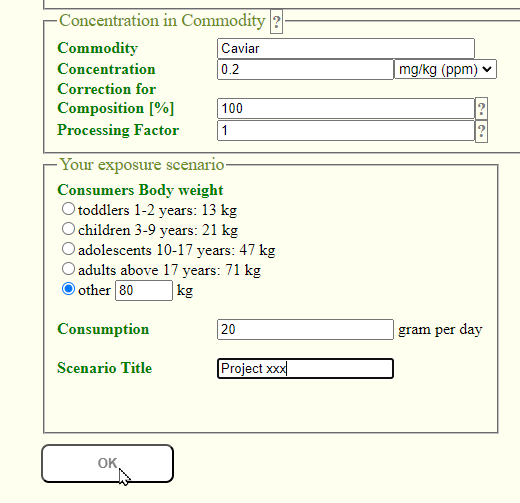 Selection of the commodity and the exposure scenario
Selection of the commodity and the exposure scenario
Selection of a food commodity
The commodity can also be searched in the database. You provide a name in the search field where a (part of a) name can be used. The system will look for a commodity in its database that fits your input. For example input of "Egg" leads to a list with commodities, like aubergines [egg plants], birds eggs, eggs: chicken, and more. These commodities are presented with radio buttons. You are asked to select one commodity from that list.
With EAST 2 and EAST 3 you can also select your commodity from a fixed list. Here the commodities are ordered according to increasing detailed (EFSA Foodex) levels. As an example in EAST 2: Vegetables ➛ Brassica vegetables ➛ Flowering Brassica ➛ Broccoli. At each level you can select a commodity, or a group of commodities for the expsoure assessment. You should be aware that when selecting a group, the exposure is calculated using the consumption quantities of the whole group with the same concentration for the chemical. Such a scenario might be rather unlikely.
The concentration
For a commodity, the concentration of the chemical and its unit from a drop down list (mg per kg or ug per kg or ng per kg) is to be provided.
The concentration can be corrected for composition of the commodity and for processing. The composition can be corrected by a percentage. E.g. when a concentration is reported per kg fat, then the system has to correct the concentration for the amount of fat in the commodity. In this way the system will calculate the concentration on a product basis. Another example: the report gives a concentration of a chemical in cheese. A pizza contains 28% cheese. Then the concentration in pizza can be recalculated using the concentration in cheese.
Correction for processing is a procedure usually done for pesticides, e.g. for calculation of concentrations in canned foods on the basis of analysis of raw food samples. To obtain the processing factors, one best can consult producers in the food industry. Some processing factors are also published in international publications and can be found on the Internet.
Scenarios
The system provides you with a list of EU scenarios. A scenario is a description of the consumption quantity (average or high percentile) and the body weight of consumers for an EU member state or group of countries. These scenarios are taken from the EFSA PRIMo database, or from EFSAs Comprehensive European Food Consumption Database.
In EAST 3 you can notice consumption surveys of different years for the same country, and for different consumer groups. Through tickboxes you are requested to select one or more scenarios.
An additional scenario
Sometimes an EU scenario does not exist for a certain commodity. For example, when additional data shows based on that the consumption quantity differs, e.g. consumption of people with a vegan diet. And consumption data can also be fully lacking in the database, for example for very rare food commodities like caviar.
In EAST 2 you can include your own value for the consumption of a commodity by using "Your exposure scenario" (in the page entitled "Concentration in a product"). In this case the input for “Commodity” is first searched in the database, for the EU scenarios. This method must be used when dealing with the situation where additional consumers are involved to be added to the EU scenarios. As an example in the figure you can see the consumption of 150 gram cow's milk per day for a consumer of 21 kg. The scenario title is optional; it will appear in the output, as a reference.

Using a commodity that is not in the database

If you are dealing with a rare commodity for which no data can be found in the database, you can only make an exposure assessment by providing the consumption quantity and body weight of the consumer yourself. That situation is addressed by giving the commodity's name in the box "Use Commodity Not in Database" (in the page "Select product").

Then include a value for the consumption of a commodity in "Your exposure scenario" (in the page "Concentration in a product"). Besides you need to select a value for the body weight of the consumer. As an example you can see the consumption of 20 gram caviar per day for a consumer of 80 kg. A scenario title is optional; it will appear in the output, as a reference.
